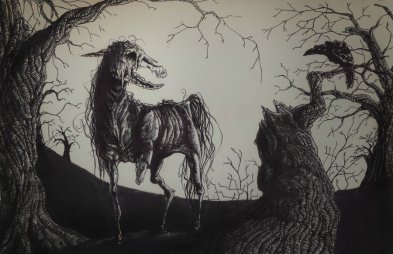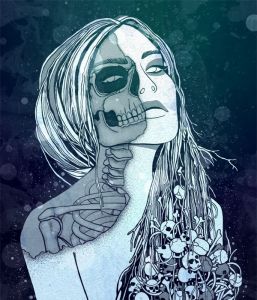The First Reading
His hands are old, his fingers older.
They reach into other years, with their walnut joints and yellow nails, and draw out the Deck of Seasons. As steady as they have always been, they remove the deck from its box of polished yew, and cut the cards, just once.
He lays the initial card upon the kitchen table, between the ashtray and the butter. A single shred of marmalade clings to the edge of the butter, burnt gold on a pale field.
The Hive. Many minds, a single thought. The card is not a threat, not in itself.
The second card, placed carefully next to the tomato ketchup, is the Bright Spear. Merciless intent. He is not surprised. It is one of the cards most coveted by the Children of Angles and Corners.
His blue-tinged lips tighten, and he glances at the sleeping dog, who snores and kicks, lost in dreams of small things which she will never catch. The joy of the chase, and the approval of others. His face relaxes, and he places the third card.
The Stone. Unwelcoming, resistant to change. It is the nature of those who are coming, after all.
He rolls a cigarette, because he still can, and places it neatly on top of the three he has already rolled this morning. The ritual matters, even though he no longer smokes. And there is a thought crouching between ragged eyebrows.
Might the card mean his own kind as well?
This is the moment of hesitation, the completion of the initial spread. The fourth card will be a charm, and show what is to come. His fingers reach into the deck without conscious thought. The card is found, turned, and placed next to the congealed egg of yesterday’s breakfast…
The Autumn Boy.
He sighs, sits back and nods his head. The weakest of the ruling cards in the Deck of Seasons. Unless you really understand the world.
Which he does.
####
We’re feeling into the northern folk-horror world today (which happens surprisingly often). Hence the extract above from The Children of Angles and Corners, which may be coming from greydog next year if he writes faster. It’s a project based on the re-emergence of the huldrefolk and other things of the past, once thought extinguished by the new religions, as the land grows cold…
As a writer (I love saying that. It’s like saying ‘as a man with a beard’, or ‘as an enthusiast of pork pies’) I have trouble with the fact that more than half of my stories do not fit anyone’s submission requirements. Or the other way round. As a man with no money, I tend to follow the requirements when I can. The huldrefolk stories are not on anyone’s buying list, but I might just hack my way through anyway. What’s three or four months of my life with no paying contracts, hey? I like ‘past-its-use-by-date’ value corned beef, really I do. Those bacteria are full of protein, aren’t they?
Hang on, I think we were blogging. Yes, so after our tripod-based last episode, we got rather carried away and wanted to write all about the Chinese Three-legged Crow, the lucky Three-legged Toad, and why the Isle of Man is such an odd place. But we haven’t (we’ll save them for another time). Art is cool with greydogtales at the moment, and so we settled for an illustration of the Helhest, the three-legged hell horse of Scandinavian lore.

The helhest is said to be associated with death and sickness. Some say that if its presence signifies death, then it appears as a black beast; if it signifies disease, then it appears white. A haunter of graveyards, the helhest legend may be based on the old custom of burying a horse in a new graveyard, the helhest being the manifestation of the sacrificed horse.
This horse’s ghost is called the ‘Helhest’. If anyone meets it, it is a sign to him of an early death. It is a tradition of the cathedral at Aarhus, that such a horse is occasionally seen there…
A Danish Parsonage, J F Vicary, 1884

The helhest is also associated, naturally, with Hel or Hela, the Norse Goddess of the Underworld, and in some stories is the beast she rides. Why it is three-legged we have no idea. Hel herself is one of Loki‘s children, along with the wolf Fenrir and the world-serpent Jormungandr. She is usually referred to as appearing discoloured on one side of her face and body, tinged with the blacks and blues of death and decay, and quite normal on the other.
This tends be portrayed rather less ickily by illustrators, who either miss out the rotting bits or depict her as skeletal on the decayed side. My own first introduction to Hel was through Marvel Comics and her appearances in Thor, where she was a mysterious figure clad in green and black.

And rather cool with it. It’s quite tragic what a teenage boy can find exciting. But here’s a more recent version:

Back to the hell horse. The first painting of the helhest at the start of the article comes from the site of the talented Jørgen Bech Pedersen, a self-taught Danish artist who produces wonderful renditions of figures from Nordic folk-lore. We shall try to get him on greydogtales if we can.

His site Troldfolk is an illustrated bestiary of such beings, and we recommend a visit. The text is in Danish, but the pictures aren’t:
The second helhest is by piasdattir on deviantart, to be found here:
All art copyright belongs to their creators, as usual.
You know that we at greydogtales like to add the odd soundwave to our posts wherever possible. So, if you’re into pagan power metal, then you really should check out Fimbulvet, a European group who slam out some heavy pagan tunes. Rather conveniently, they have recorded a track called, yes, Helhest:
Given that in some legends the barghest (see Game of Groans & Clanking Chains) is also a denizen of cemeteries and a beast of ill omen, it makes us wonder if there is any common root that connects helhest and barghest.
####
You may remember that we mentioned Andy Paciorek’s excellent illustrations a couple of weeks ago, as part of our weird art celebration. It’s worth adding that he has now finished compiling the book Folk-Horror Revival: Field Studies, and it’s available to buy. We quote:
500 pages. Illustrated throughout including artwork by Alan Lee, Paul Rumsey, Julia Jeffrey, Morgaine Art, GB. Jones and Andy Paciorek. Featuring essays and interviews by many great cinematic, musical, artistic and literary talents, Folk Horror Revival: Field Studies is the most comprehensive and engaging exploration to date of the sub genre of Folk Horror and associated fields in cinema, television, music, art, culture and folklore. Includes contributions by Kim Newman, Robin Hardy, Thomas Ligotti, Philip Pullman, Gary Lachman, Jim Moon, English Heretic, The Hare and the Moon and many many more.
100% of all profits from sales of the book will be charitably donated to environmental, wildlife and community projects undertaken by The Wildlife Trusts.
It’s available now from lulu.com
We’re grimmed out. We have some glorious longdog pictures to come next time. Also, our interview with artist and illustrator M Wayne Miller is back from the cleaners, and should be ready soon, along with many other fine pieces. Do join us, dear listeners, in a few days…
